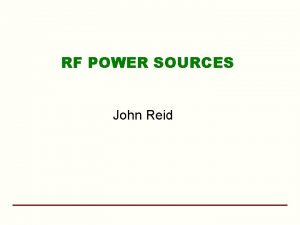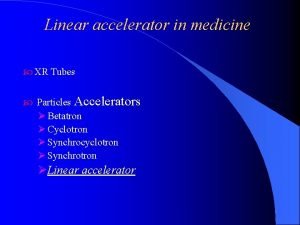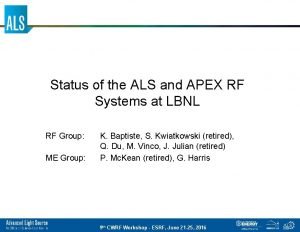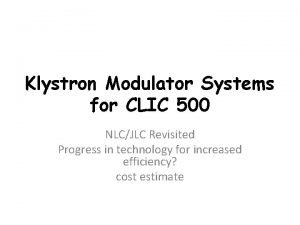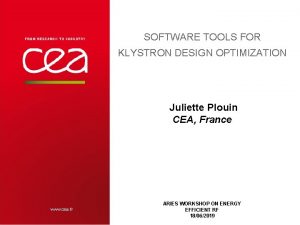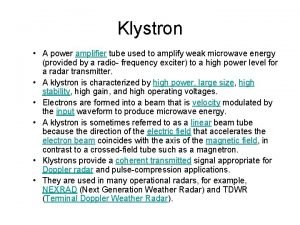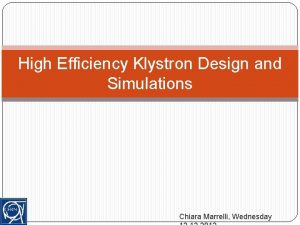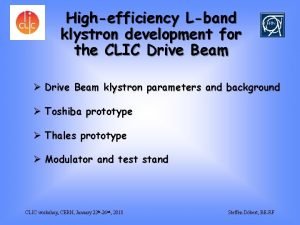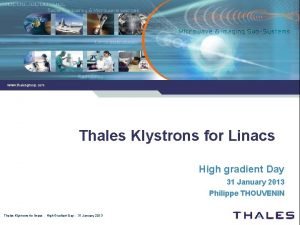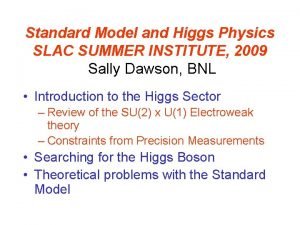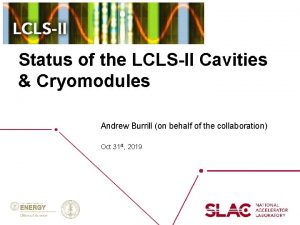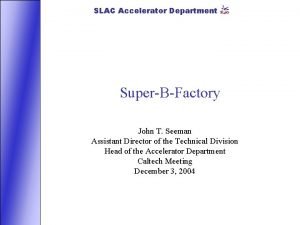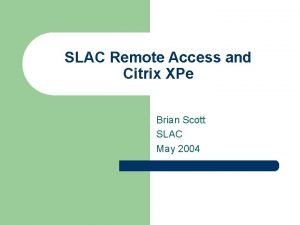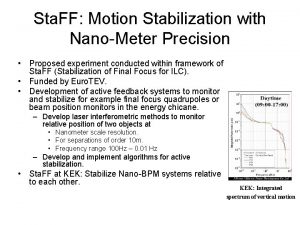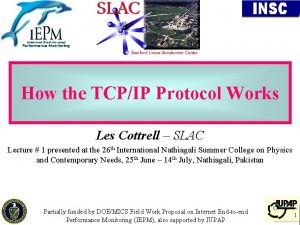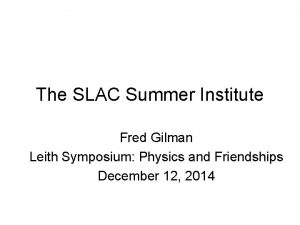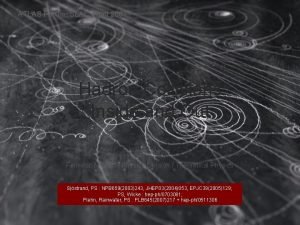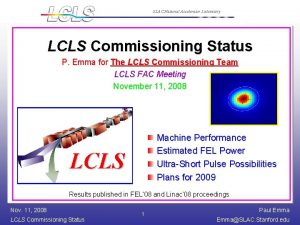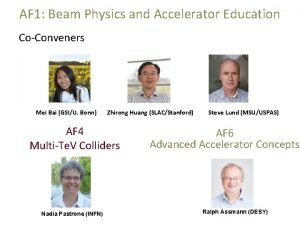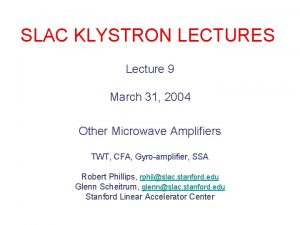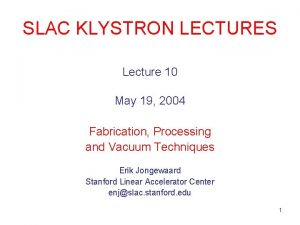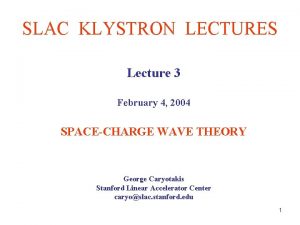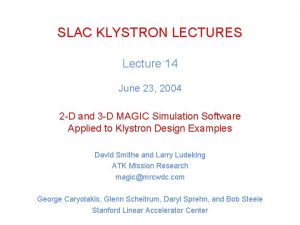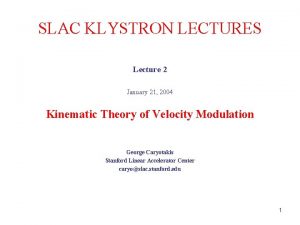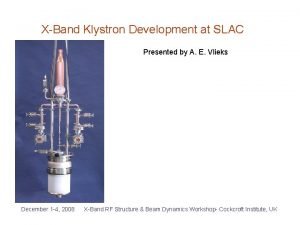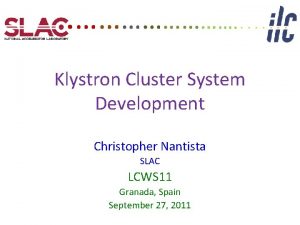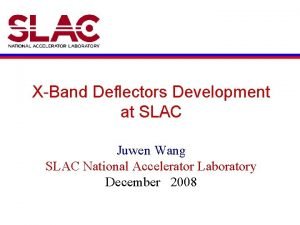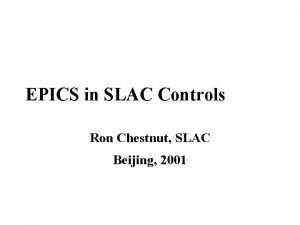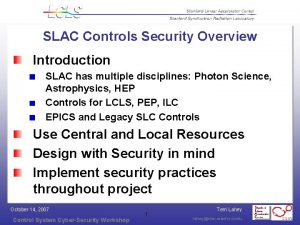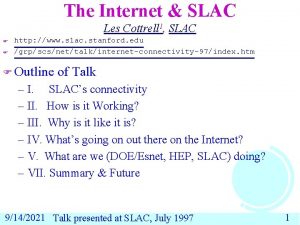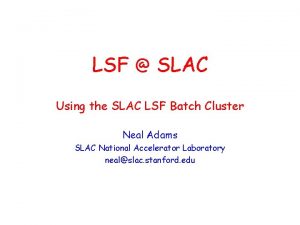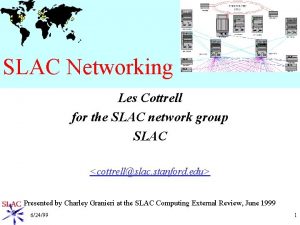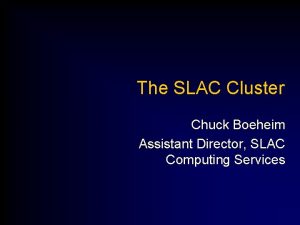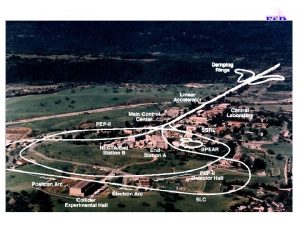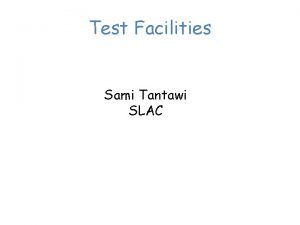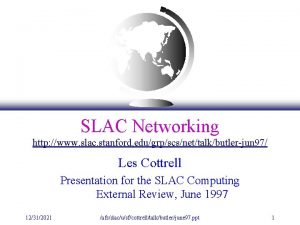SLAC KLYSTRON LECTURES Lecture 8 March 24 2004






















- Slides: 22

SLAC KLYSTRON LECTURES Lecture 8 March 24, 2004 Calculating and Measuring R/Q Tube Engineers Do It Differently Glenn Scheitrum Stanford Linear Accelerator Center glenn@slac. stanford. edu

Resources required: Electromagnetic field simulation code SUPERFISH – 2 D deformable mesh eigenmode solver Available by FTP, see instructions at http: //laacg 1. lanl. gov/laacg/services/psann. html#ftp MAGIC, MAFIA, HFSS, ARGUS, FEMLAB, etc. – Commercial 2 D and 3 D electromagnetic field solvers Useful tools: Mathcad, Excel, ascii editor References: Microwave Measurements, Ginzton

R/Q (shunt impedance) is a figure of merit for a resonant structure doing work on an electron beam. It relates the integrated voltage developed along a given path (usually the axis) to the energy required to produce the voltage. At resonance the cavity impedance is resistive since the inductive and capacitive reactances cancel. The voltage for the resonant cavity can be defined as the integral of the axial electric field (Ez) at r = 0.

TM 010 pillbox cavity. radius = a =. 0115 height = d =. 0115 freq = 10 GHz

R/Q is a function of geometry but not frequency or wall losses in the cavity. A W -band cavity that is a scaled copy of an L-band cavity will have exactly the same R/Q. Checking the units: R/Q = (E*d)2 / (2 *½( E 2)*d 3) = 1 / ( d) = ohms Calculation of R/Q can be done with any simulation software that solves for cavity fields given the cavity geometry. This includes SUPERFISH, MAGIC, MAFIA, HFSS, etc. SUPERFISH will do 2 D cylindrically symmetric structures but there are some pitfalls that must be avoided.

Caveat: SUPERFISH was written by accelerator physicists. They treat R/Q differently than tube engineers. In SUPERFISH, the postprocessor SFO will report a “Shunt Impedance” and an “r/Q”. Neither one is the R/Q used by tube engineers. Shunt impedance is (E 02 L)/P, an impedance per unit length and r/Q = (V 0 T)2/ U, where T (called a transit time factor) is equivalent to our coupling factor M. If everything in the simulation is set up correctly, so that SUPERFISH integrates the voltage along the correct path, the cavity center is at z = 0 and the correct beam velocity has been used, then the R/Q = (r/Q)/(2 T 2). The factor of ½ converts the peak voltage values to RMS values. If everything is not set up correctly, the voltage along the axis (or other desired path) can be calculated by the SF 7 postprocessor and the internal integration routine in TABLPLOT. The stored energy is already reported in SFO.

PILL 10. af SUPERISH input file listing 10 -GHz TM 010 Short Pillbox Cavity reg kprob=1, ; Superfish problem dx=. 02, ; X mesh spacing freq=10000. , ; Starting frequency in MHz xdri=1. , ydri=1. 14741 $ ; Drive point location $po x=0. 0, y=0. 0 $ ; Start of the boundary points $po x=0. 0, y=1. 14741 $ ; r = 1. 14741 cm $po x=1. 14741, y=1. 14741 $ ; z = 1. 14741 cm, r = 1. 14741 cm $po x=1. 14741, y=0. 0 $ ; $po x=0. 0, y=0. 0 $ ; note closed structure has same ; entries for first and last point ; In SUPERFISH cylindrically symmetric problems ; x= z, y= r To run AUTOFISH, double click on the “PILL 10. af” filename. It will output several files. PILL 10. T 35, PILL 10. SFO, OUTAUT. TXT, OUTFIS. TXT, etc. If it fails to complete, read the two text files to find the error and correct it.

Last page of PILL 10. SFO Superfish output summary for problem description: 10 -GHz TM 010 Short Pillbox Cavity ---------------------------------------All calculated values below refer to the mesh geometry only. Field normalization (NORM = 0): EZERO = 1. 00000 MV/m Frequency = 10000. 09011 MHz Particle rest mass energy = 938. 271998 Me. V Beta = 0. 7654765 Kinetic energy = 519. 886 Me. V Normalization factor for E 0 = 1. 000 MV/m = 5187. 058 Transit-time factor Abs(T+i. S) = 0. 0000031 Stored energy = 5. 65182 E-06 Joules Using standard room-temperature copper. Surface resistance = 26. 08934 milli. Ohm Normal-conductor resistivity = 1. 72410 micro. Ohm-cm Operating temperature = 20. 0000 C Power dissipation = 20. 4561 W Q = 17360. 0 Shunt impedance = 560. 912 MOhm/m Rs*Q = 452. 910 Ohm Z*T*T = 0. 000 MOhm/m r/Q = 0. 000 Ohm Wake loss parameter = 0. 00000 V/p. C Average magnetic field on the outer wall = 1376. 86 A/m, 2. 47293 W/cm^2 Maximum H (at Z, R = 0. 96624, 1. 14741) = 1376. 85 A/m, 2. 47291 W/cm^2 Maximum E (at Z, R = 1. 13735, 1. 14741) = 1. 00356 E-04 MV/m, 1. 2215 E-06 Kilp. Ratio of peak fields Bmax/Emax = 17240. 6426 m. T/(MV/m) Peak-to-average ratio Emax/E 0 = 0. 0001

Right click on PILL 10. T 35 and choose (Interpolate SF 7) The dialog box on the right is used to select the start and stop points for a line along the axis of the cavity. When run, it creates a TABLPLOT file named PILL 1001. TBL which contains electric field data for Ez and Er along the specified line.


One of the drop-down menu choices from the TABLPLOT file is “Integrate”. Clicking on it opens the dialog box on the right. It lets you define the limits of integration and field value to be integrated (Ez, Er, |E|, H). In this case the normalization done in SUPERFISH produced an Eo value of 1 MV/m. Since the electric field is constant vs z, the integral is just Eo*(z 2 -z 1) Integrated Voltage = 11. 4741 k. V Resonant frequency = 10 GHz Stored Energy U = 5. 65182 E-06 J R/Q = V 2/2 U = 185. 37

Trying something a little more complex - 3 gap output cavity from SLAC’s XL-1 was the first of a series of 11. 424 GHz 50 MW klystrons for the NLC. It used a 3 gap standing wave cavity to reduce the electric field gradient in the output cavity. Numbers correspond to points defined in input file.

R/Q for SLAC’s XL 1 three cell standing wave output cavity. File “XL-1_3 gap. af” 11. 4 -GHz XL-1 3 gap standing wave output cavity $reg kprob=1, ; Superfish problem dx=. 010, ; X mesh spacing freq=11424. , ; Starting frequency in MHz xdri=1. 5, ydri=0. 5792, ; Drive point location conv=2. 54 $ ; Dimensions are in inches $po x=0. 0, y=0. 0 $ ; Start of the boundary points $po x=0. 0, y=0. 1875 $ ; drift tube radius = 0. 1875 in $po x=1. 0, y=0. 1875 $ ; drift tube length = 1. 0 in, r = 0. 1875 in $po nt=2, x 0=1. 0, y 0=0. 2661, r=0. 0786, theta=360 $ ; radius of cavity edge $po x=1. 0786, y=0. 5792 $ ; left cavity backwall radius =. 5792 in $po x=1. 1693, y=0. 5792 $ ; spacer width =. 0907 in $po x=1. 1693, y=0. 47 $ ; start of radius $po nt=2, x 0=1. 2945, y 0=0. 47, r=0. 1252, theta=360 $ ; 180 degree arc for disk aperture $po x=1. 4197, y=0. 5792 $ ; center cavity backwall radius =. 5792 in $po x=1. 56, y=0. 5792 $ ; spacer width =. 1403 in $po x=1. 56, y=0. 47 $ ; start of radius $po nt=2, x 0=1. 6852, y 0=0. 47, r=0. 1252, theta=360 $ ; 180 degree arc for disk aperture $po x=1. 8104, y=0. 5384 $ ; right cavity backwall radius =. 5384 in $po x=1. 9507, y=0. 5384 $ ; spacer width =. 1403 in $po x=1. 9507, y=0. 2661 $ $po nt=2, x 0=2. 0293, y 0=0. 2661, r=0. 0786, theta=270 $ $po x=3. 0293, y=0. 1875 $ ; drift tube $po x=3. 0293, y=0. 0 $ $po x=0. 0, y=0. 0 $ ; 1 2 3 4 5 6 7 8 9 10 11 12 13 14 15 16 17 18

R/Q for SLAC’s XL 1 three cell standing wave output cavity.

Superfish output summary for problem description: 11. 4 -GHz XL-1 3 gap standing wave output cavity ---------------------------------------All calculated values below refer to the mesh geometry only. Field normalization (NORM = 0): EZERO = 1. 00000 MV/m Frequency = 11452. 31327 MHz Particle rest mass energy = 938. 271998 Me. V Beta = 1. 0000000 Normalization factor for E 0 = 1. 000 MV/m = 94181. 405 Transit-time factor Abs(T+i. S) = 0. 6550239 Stored energy = 0. 0012806 Joules Using standard room-temperature copper. Surface resistance = 27. 91950 milli. Ohm Normal-conductor resistivity = 1. 72410 micro. Ohm-cm Operating temperature = 20. 0000 C Power dissipation = 20. 0765 k. W Q = 4589. 74 Shunt impedance = 3. 833 MOhm/m Rs*Q = 128. 143 Ohm Z*T*T = 1. 644 MOhm/m r/Q = 27. 567 Ohm Wake loss parameter = 0. 49591 V/p. C Average magnetic field on the outer wall = 23025. 5 A/m, 740. 11 W/cm^2 Maximum H (at Z, R = 1. 4197, 0. 5288) = 26129. 9 A/m, 953. 134 W/cm^2 Maximum E (at Z, R = 1. 57952, 0. 402874) = 9. 92618 MV/m, 0. 113264 Kilp. Ratio of peak fields Bmax/Emax = 3. 3080 m. T/(MV/m) Peak-to-average ratio Emax/E 0 = 9. 9262


Absolute value of Ez vs z (edit TABLPLOT file by hand)

R/Q for 3 gap XL-1 output cavity Stored energy = 0. 0012806 Joules R/Q = V 2/2 U Note: integral has mixed units Ez is in MV/m but z is in inches V = 3. 0293 MV-in/m *. 0254 m/in = 76. 9 k. V R/Q = 64. 25

Since the voltage in the gap varies radially as I 0( r), the effective shunt impedance depends on both filling factor and a. If a is 2 the electric field at the edge of the beam can be 40% higher than on axis. This is partially compensated by the reduced fringing of the cavity field into the drift region at a larger radius. For the XL-1, a =. 74 Calculate R/Q at beam edge and at r =. 707 rb (assume 60% fill factor) Use SF 7 to obtain integrated voltage at each radius. R/Q(r=0) = 64. 25 R/Q(r=. 707 rb) = 64. 62 R/Q(r=rb) = 65. 26 For this a, the difference in integrated voltage from axis to beam edge is small and can be neglected.



Summary R/Q can be easily and accurately calculated using SUPERFISH (or another electromagnetic code of your choice) Although SUPERFISH doesn’t calculate the tube engineer’s version of R/Q directly, it provides almost all the tools necessary to do so. Homework: Acquire SUPERFISH from Los Alamos Modify either PILL 10. af or XL-1_3 gap. af input file (or use your own geometry) Calculate R/Q on axis and at r=. 6*ra
 March march dabrowski
March march dabrowski Mwatt to kwatt
Mwatt to kwatt Flatining
Flatining Thales klystron
Thales klystron Klystron price
Klystron price Klystron design
Klystron design Klystron power amplifier
Klystron power amplifier Klystron design
Klystron design Gchf.pk
Gchf.pk Thales klystron
Thales klystron 01:640:244 lecture notes - lecture 15: plat, idah, farad
01:640:244 lecture notes - lecture 15: plat, idah, farad Slac vpn
Slac vpn Slac summer institute
Slac summer institute Andrew burrill slac
Andrew burrill slac Slac
Slac Stanford citrix
Stanford citrix Slac sta
Slac sta Ip fragmentation
Ip fragmentation Slac summer school
Slac summer school Slac
Slac Network data collection at slac
Network data collection at slac Statusp
Statusp Mei bai slac
Mei bai slac

